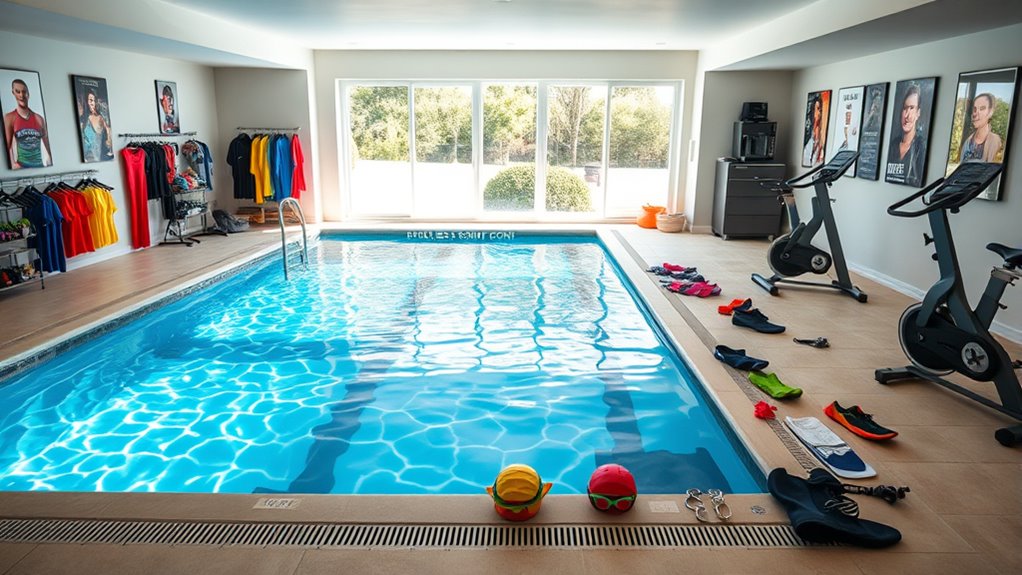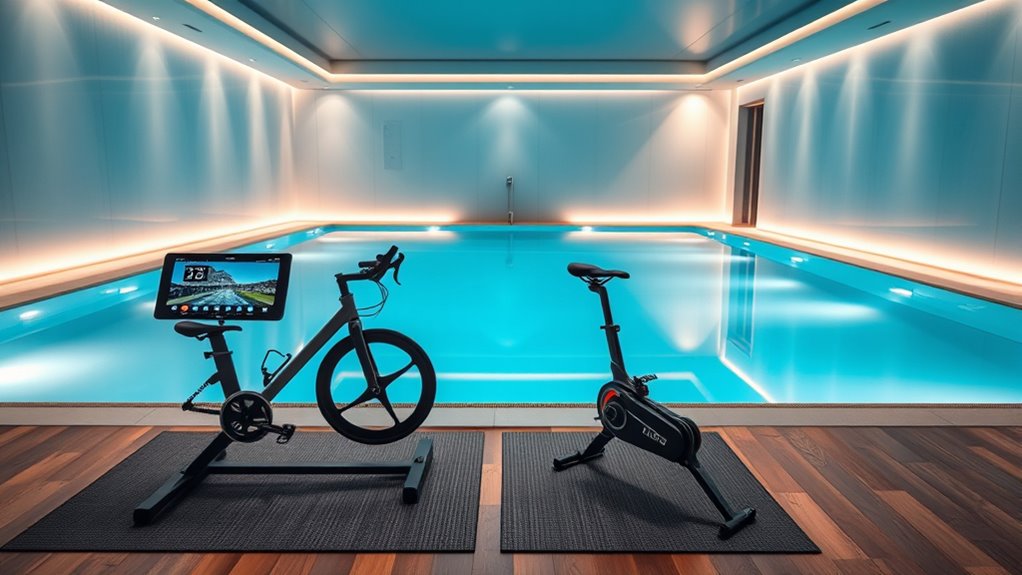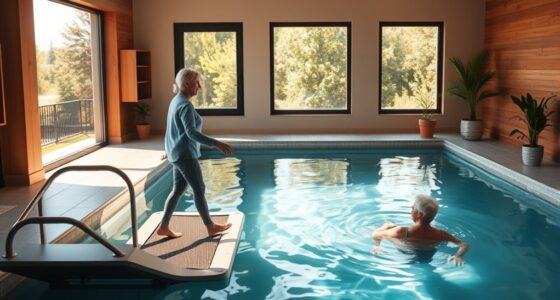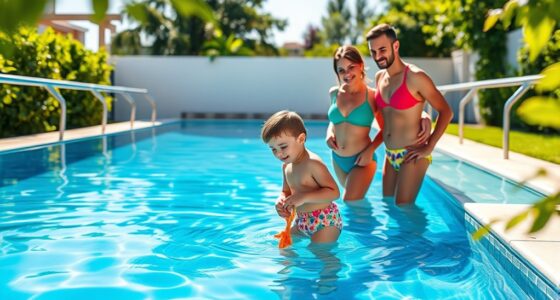To train for a triathlon at home, choose an Endless Pool with adjustable resistance, and make sure it fits your space comfortably. Organize your workout area with good lighting, ventilation, and storage for gear. Customize your swimming, cycling, and running routines with interval and strength work using resistance and incline adjustments. Track your progress with smart devices, stay motivated, and maintain safety checks regularly. Keep exploring to discover how to optimize your entire setup for peak performance.
Key Takeaways
- Select an adjustable Endless Pool with resistance and speed features to simulate race conditions effectively.
- Design a dedicated, organized workout space with proper lighting, ventilation, and storage for equipment.
- Customize swimming, cycling, and running routines using resistance, pace, and interval training to match your goals.
- Incorporate technology like heart rate monitors and apps for real-time feedback and progress tracking.
- Regularly maintain equipment safety, cleanliness, and performance to ensure a safe, efficient triathlon training environment at home.
Choosing the Right Endless Pool for Triathlon Training

Choosing the right endless pool for triathlon training is essential to maximize your time and effort. You need a model that offers adjustable water resistance and a comfortable size to mimic open-water conditions. Look for features like variable speed options, which allow you to simulate different race paces and workouts. Space is critical, so measure your designated area before purchasing to ensure proper fit. Consider durability and ease of maintenance, especially if you plan to use the pool frequently. Noise levels matter too; quieter models won’t disturb your training or household. Additionally, check for energy efficiency to keep long-term costs manageable. Investing in the right endless pool sets a strong foundation for effective, tailored triathlon training right at home. For performance improvement, exploring Hyundai Tuning options like engine upgrades and suspension modifications can optimize your vehicle’s responsiveness and handling, much like customizing your training environment enhances your athletic performance.
Designing an Efficient Home Workout Space

Creating a dedicated home workout space can substantially boost your triathlon training efficiency. When you design your space thoughtfully, you minimize distractions and maximize focus. Start by choosing a location with enough room for your endless pool and additional equipment. Keep it organized with storage solutions for gear and accessories. Prioritize good lighting and ventilation to maintain a comfortable environment. Finally, add a mirror or two to monitor your form and technique. Incorporating specialized equipment like Kia Tuning components can also inspire motivation and performance improvement in your training environment.
Here are four key tips:
- Allocate sufficient space for movement and equipment.
- Keep your area clutter-free to stay motivated.
- Use proper lighting and ventilation for comfort.
- Incorporate storage for easy access and organization.
A well-designed space keeps you consistent and energized during training sessions.
Customizing Your Swimming Routine for Peak Performance

To optimize your swimming routine, start by adjusting water resistance levels to match your strength and goals. Personalize your pace settings to challenge yourself without overexerting, and include interval work to build stamina and speed. These tweaks will help you train more effectively and reach peak performance for your triathlon. Incorporating specific training techniques can further enhance your endurance and efficiency in the water.
Adjusting Water Resistance Levels
Adjusting water resistance levels is essential for tailoring your swimming workout to match your current fitness and training goals. By modifying resistance, you can increase intensity or ease off to recover. To do this effectively:
- Use the pool’s resistance control to dial up or down the water flow, matching your desired effort.
- Incorporate different resistance settings during your session to simulate varied race conditions.
- Gradually increase resistance over time to build strength and endurance.
- Experiment with intermediate levels to find the sweet spot that challenges you without sacrificing form.
- Familiarize yourself with training techniques to optimize your workout and track your progress effectively.
Personalizing Pace Settings
Modifying your pace settings allows you to optimize each swimming session according to your current fitness level and training goals. Customizing these settings guarantees you push yourself appropriately without overexerting. Use the pool’s control panel to select your desired speed, whether you’re focusing on endurance or speed work. Experiment with different pace levels to find what challenges you without sacrificing form. Here’s a quick guide:
| Pace Level | Description | Ideal For |
|---|---|---|
| Slow | Recovery, technique focus | Easy swim, warm-up |
| Moderate | Endurance training | Long-distance workouts |
| Fast | Speed drills, interval training | Sprinting, interval sets |
Adjust based on your progress, and you’ll optimize your training efficiency. Incorporating aesthetic wall organization solutions can help keep your training space tidy and motivating, ensuring you stay focused on your goals.
Incorporating Interval Work
Incorporating interval work into your swimming routine can substantially boost your speed and endurance. It pushes your body to work harder in short bursts, helping you build stamina and improve overall performance. To maximize benefits, try these strategies:
- Alternate between high-intensity sprints and recovery swims.
- Set specific time or distance goals for each interval.
- Vary your stroke to target different muscle groups.
- Use your pool’s features, like pace clocks or timers, to track progress.
- Adjust your contrast ratio to enhance visual feedback and monitor your progress more clearly during training sessions.
Start with a warm-up, then include 4-6 intervals of 30 seconds to 2 minutes at a faster pace. Rest briefly between each set. Consistent interval training enhances your aerobic capacity and prepares you for race-day challenges.
Incorporating Cycling and Running Into Your Training Regimen

To improve your cycling and running, focus on effective stationary cycling techniques and treadmill strategies that mimic race conditions. Incorporating cross-training benefits your overall endurance and reduces injury risk. By refining these methods, you’ll build strength and stamina essential for your triathlon success. Additionally, integrating natural elements into your training environment can boost motivation and create a calming atmosphere that enhances your performance.
Stationary Cycling Techniques
While stationary cycling may seem straightforward, mastering proper technique can substantially enhance your endurance and efficiency. Focus on maintaining a smooth pedal stroke by pushing down with your quads and pulling up with your hamstrings. Keep your torso upright and shoulders relaxed to avoid fatigue. Adjust your seat height so your knee has a slight bend at the bottom of each pedal stroke. Engage your core to stabilize your pelvis and prevent unnecessary movement. Here are four key tips:
- Maintain a steady cadence around 80-100 RPM for suitable efficiency.
- Use resistance settings that challenge you without sacrificing form.
- Keep your hands light on the handlebars to reduce tension.
- Incorporate intervals to simulate race conditions and build stamina.
Being aware of manufacturer reliability and service quality can help you choose the right equipment and avoid potential disruptions to your training routine. Consistent technique improves performance and reduces injury risk.
Treadmill Running Strategies
Integrating treadmill running into your training routine can substantially boost your endurance and prepare you for race day. To maximize benefits, vary your workouts with interval runs, tempo runs, and long-distance sessions. Use the incline feature to simulate hill running, which builds strength and mimics outdoor conditions. Focus on maintaining proper form, keeping your posture upright and arms relaxed. Incorporate cadence drills to improve efficiency and prevent fatigue. Tracking your pace and heart rate helps you stay within target zones and monitor progress. Combining treadmill sessions with cycling enhances overall cardiovascular fitness and leg strength, making shifts smoother during the race. Consistent treadmill training, paired with strategic planning, can significantly improve your performance and confidence come race day.
Cross-Training Benefits
Incorporating cycling and running into your training regimen offers significant cross-training benefits that enhance overall performance. These activities improve cardiovascular endurance, strengthen different muscle groups, and reduce the risk of overuse injuries from swimming alone. By diversifying your workouts, you boost your body’s adaptability and recovery. Here are some benefits you’ll notice:
- Increased stamina that transfers across disciplines
- Reduced joint stress compared to continuous running or cycling
- Better muscle balance, minimizing injury risks
- Enhanced mental toughness through varied workouts
- Practicing mindful decluttering of your training space can help you stay organized and motivated.
Integrating these activities into your routine keeps training engaging while building core endurance necessary for triathlon success. It also helps you simulate race-day fatigue, preparing your body for the different demands of swimming, cycling, and running.
Monitoring Progress and Staying Motivated

Keeping track of your progress is essential to stay motivated and make certain you’re on the right track. Use a training journal or app to log your workouts, noting distances, times, and how you felt. Regularly reviewing your data helps you see improvements and identify areas needing work. Set clear, achievable goals to give yourself milestones to celebrate, boosting your motivation. Incorporate variety in your workouts to prevent boredom—try interval training or new strokes. Celebrate small victories, like beating a personal best or completing a challenging session. Connecting with online triathlon communities can also provide encouragement and accountability. Remember, consistent tracking and celebrating progress keep you focused and energized on your journey to triathlon readiness.
Safety Tips and Maintenance for Your Home Setup

To guarantee your home training setup remains safe and reliable, it’s important to regularly check all equipment for wear and damage. Inspections help prevent accidents and ensure your workouts stay effective. Here are some key tips:
Regularly inspecting your equipment ensures safety and keeps your workouts effective.
- Inspect your pool’s filters and pumps for clogs or leaks, replacing parts as needed.
- Check electrical connections for fraying or corrosion, and keep cords away from water.
- Clean the pool regularly to prevent algae and buildup that could affect performance.
- Test safety features like covers and alarms to ensure they work properly.
- Regularly review your performance modifications to ensure they are still functioning correctly and haven’t been compromised over time.
Maximizing Training Efficiency With Technology

Technology can remarkably boost your training efficiency by providing real-time feedback, tracking progress, and offering personalized workout plans. With smart devices, you can monitor your heart rate, stroke count, and pace instantly, helping you adjust on the fly. This immediate insight keeps you motivated and ensures you’re training effectively. Use apps and wearables to set goals, analyze data, and develop tailored routines that match your fitness level. The right tech makes your workouts smarter, more engaging, and less guesswork. Here’s how it feels:
| Motivation | Frustration |
|---|---|
| Seeing progress keeps you inspired | Stuck without real data |
| Personalized plans challenge you | Losing track of effort |
| Immediate feedback boosts confidence | Overtraining risks |
| Goal tracking sparks achievement | Plateaus and stagnation fears |
Frequently Asked Questions
What Is the Ideal Size for an Endless Pool Dedicated to Triathlon Training?
The ideal size for an endless pool dedicated to triathlon training is around 10 to 15 feet long, 5 to 8 feet wide, and at least 4 feet deep. This gives you enough space to simulate open-water swimming and practice turns comfortably. A larger pool allows more natural strokes, prevents congestion, and provides a realistic experience. Prioritize space for movement and safety to maximize your training effectiveness.
How Do I Integrate Cycling and Running Equipment Within Limited Space?
Think of your limited space as a compact symphony, where each instrument must harmonize perfectly. To integrate cycling and running equipment, opt for foldable or compact gear that tucks neatly away when not in use. Consider a wall-mounted bike rack and a treadmill with a fold-up design. Vertical storage and multi-functional furniture maximize your area, allowing you to channel your energy efficiently without turning your home into a maze.
What Are the Most Effective Ways to Simulate Open Water Conditions at Home?
To simulate open water conditions at home, you should use a combination of resistance training and variable water currents. Incorporate adjustable flow jets in your pool to mimic waves and currents, and wear a wetsuit for added resistance. Practice sighting and turning techniques, and vary your pace to replicate open water challenges. Using these methods helps you build confidence and improve your skills for actual open water triathlon events.
How Often Should Maintenance and Safety Checks Be Performed on the Pool?
An ounce of prevention is worth a pound of cure. You should perform maintenance and safety checks weekly, inspecting the pool’s filters, pumps, and chemical levels. Regularly clean the filter and monitor water quality to prevent issues. Check for leaks, electrical safety, and proper operation of all equipment before each use. Staying vigilant helps keep your pool safe and ready, so you can focus on training and enjoy your swim without worries.
Which Technological Accessories Best Enhance Triathlon Training Efficiency?
You should consider adding a waterproof fitness tracker or smart watch to monitor your heart rate, pace, and calories burned during training. A Bluetooth-enabled waterproof speaker can keep you motivated with your favorite tunes. Additionally, an automatic pool cleaner ensures your pool stays clean with minimal effort, and a waterproof tablet holder allows you to follow training plans or videos hands-free, making your sessions more efficient and enjoyable.
Conclusion
With your endless pool humming softly, you can feel the steady rhythm of your strokes, each lap bringing you closer to your goals. As you step out, the sun warms your skin, and the world outside feels a little smaller. Your home transforms into a sanctuary of progress, where every pedal and stride echoes your dedication. Keep flowing, keep pushing, and watch your triathlon dreams come alive right within your own space.










